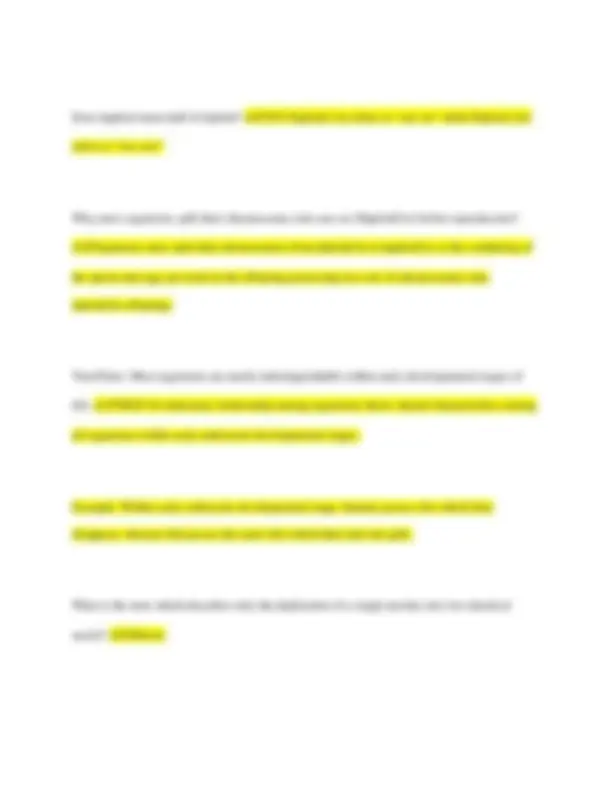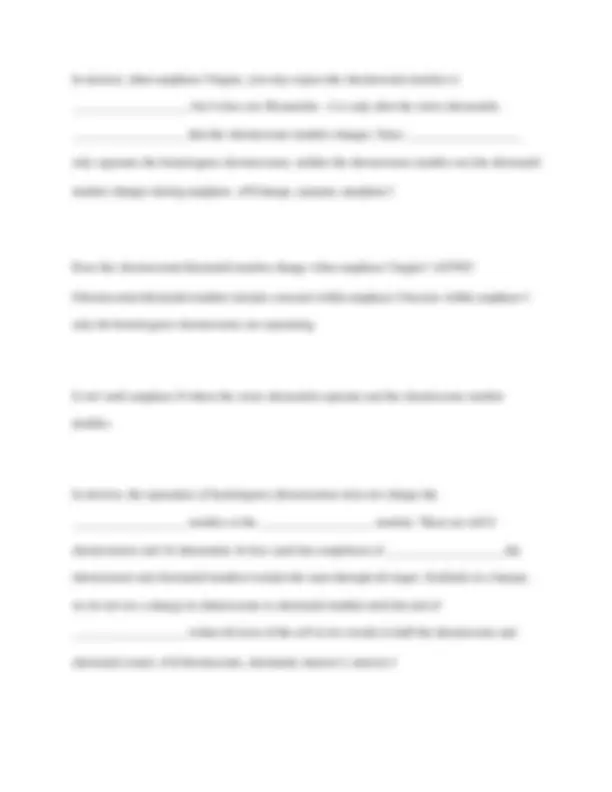






























































Study with the several resources on Docsity

Earn points by helping other students or get them with a premium plan


Prepare for your exams
Study with the several resources on Docsity

Earn points to download
Earn points by helping other students or get them with a premium plan
Community
Ask the community for help and clear up your study doubts
Discover the best universities in your country according to Docsity users
Free resources
Download our free guides on studying techniques, anxiety management strategies, and thesis advice from Docsity tutors
This study guide covers key concepts in cell biology, including cell theory, cell reproduction, mitosis, meiosis, and the structure of chromosomes. It provides detailed explanations of these processes, along with examples and diagrams to aid understanding. The guide also includes practice questions and answers to reinforce learning.
Typology: Exams
1 / 68

This page cannot be seen from the preview
Don't miss anything!





























































What is the cell theory? ✔✔All organisms are made come from cells and are made up of cells
Cells must reproduce for what 2 reasons? ✔✔Cells must reproduce either to perpetuate the species or create a multi-celled individual
Cell reproduction involves which two processes? ✔✔Cell reproduction involves mitosis (duplication and division of the nucleus) and cytokinesis (division of the rest of the cell)
If the process of cell reproduction via mitosis & cytokinesis produces identical (clone) cells, then which cell reproductive process causes variation within offspring? ✔✔Meiosis (sexual reproduction) causes variation within offspring because it involves the combining of two differing sets of genetics from two different individuals.
Mitosis (a-sexual reproduction) involves the duplication and splitting of a single nucleus, which results in two identical (clone) cells.
Although siblings may be of the same sex, they alter in appearance. Would they be considered mutants? ✔✔No, differences between siblings are based on Meiosis, not mutations.
What is the difference between Asexual reproduction and Sexual reproduction? ✔✔Within Asexual reproduction, an organism reproduces asexually (without a partner) which results in offspring being identical (clones).
Within Sexual reproduction, an organism requires a partner to produce sexually which results in variation among offspring.
What is a big disadvantage to Asexual reproduction? How is it threatening to a population? ✔✔A big disadvantage to Asexual reproduction is that all offspring are identical (clones). With all offspring being identical, there is much more risk of the entire population being susceptible to a virus/infection.
What is the ploidy for humans? ✔✔1n = 23, with 2n = 46 total chromosomes
1n (Haploid = 1 set)
2n (Diploid = 2 set)
What is the term of which describes dividing two identical nuclei as well as the remaining cytocontents? ✔✔Cytokinesis
What is the difference between Mitosis and Cytokinesis? ✔✔Mitosis is the process of duplicating a single nucleus into two identical nuclei,
Cytokinesis is the splitting of those two nuclei into two identical cells.
Which occurs first? Mitosis or Cytokinesis? ✔✔Mitosis occurs BEFORE Cytokinesis
Mitosis = Duplication, Cytokinesis = Splitting
Is mitosis synonymous with cell division or cell reproduction? ✔✔NO! Mitosis is technically only the duplication of a single nucleus,
CYTOKINESIS is the process of cell division, hence cytokinesis MUST occur for cell division to occur
True/False Cytokinesis is the process of cell division? ✔✔True!
Would interphase be considered the "resting" phase of the cell? ✔✔No! Chemical reactions / Cellular respiration / Photosynthesis occurs within interphase, hence interphase is full of function
What is produced within the Synthesis Phase? ✔✔Chromosomes are duplicated and DNA is synthesized within the Synthesis Phase of interphase
There are two gap phases within interphase, are they before or after the synthesis phase? ✔✔G aka First gap phase is BEFORE the synthesis phase while G2 aka Second gap phase is AFTER the synthesis phase
Within the S (synthesis) Phase, DNA is in a coiled form called what? ✔✔Chromatin
What are the three phases of interphase? What is their order? ✔✔G1 (First gap phase)
S (synthesis (DNA) phase)
G2 (second gap phase)
What is the process of ONLY separating two nuclei and other extracellular content into two daughter cells? ✔✔Cytokinesis
During which phase of the cell cycle are chromosomes duplicated and DNA synthesized? ✔✔S - Synthesis phase (within interphase)
What type/form of DNA is within the synthesis phase? ✔✔Chromatin
During which metabolically active phase do cells spend most of their time? ✔✔G1 phase of interphase
Is it true that some cells of which do not plan on duplicating can remain within the G1 phase? ✔✔TRUE - Cells that don't divide can remain within the G1 stage (also referred to as G0 stage)
What occurs within the G2 stage? ✔✔To supply additional structures such as tubulin in the form of microtubules so that we can move things around within the mitotic and cytokinetic stages
What are the two histones? What do they appear as? ✔✔The two histones are the:
Core - Center, wrapped with DNA which is held by the H1 histone
H1 - Clamps DNA to the Core
What is a nucleosome? ✔✔Turns of DNA wrapped around a core histone locked in place by an H1 histone.
What are nonhistones? ✔✔Nonhistones are proteins such as histones but remain within the chromatin once histones are removed
Where are histones located? ✔✔Within the chromatin
What is each half of a chromosome called? ✔✔A chromatid
Where are chromatids connected? ✔✔The centromere
What are two identical chromatids bonded together at the centromere called? ✔✔Two chromatids bonded together is a duplicated Monad chromosome
IF the 23rd pair is identical, it is a female, if the 23rd pair is a non-pair, it is a male.
What are autosomes? Do they play role in determination of sex? ✔✔Autosomes are the pairs of chromosomes of which DO NOT determine the sex of the organism
What occurs within Interphase? ✔✔Tubulin is formed into microtubules which are then formed into spindle fibers & asters
What are the stages of mitosis? ✔✔prophase, metaphase, anaphase, telophase
Why is interphase NOT a stage of mitosis? ✔✔mitosis cannot occur without the DNA duplication which must take place within interphase
T/F You can visually see if DNA has been duplicated within interphase? ✔✔FALSE, you cannot see if DNA has been duplicated within interphase
During which stage of mitosis do these events occur:
-"chromosomes begin to appear as an X"
-the nuclear envelope begins to disappear,
-nucleolus disappears,
-long thread-like bodies of chromatin become evident and begin to condense as visible chromosomes
-chromosomes continue to shorten and thicken
-spindle forms between the centrioles, which have moved to the poles of the cell ✔✔Prophase
During which stage of mitosis do these events occur:
-spindle fibers attach to the kinetochores of the chromosomes
-chromosomes line up along the equatorial plane of the cell ✔✔Metaphase
During which stage of mitosis do these events occur:
-chromatids separate at their centromeres, and one group of chromosomes moves toward each pole
-division of the cytoplasm, cytokinesis, has not yet occurred ✔✔Anaphase
What is the Sliding filament hypothesis? ✔✔The sliding filament hypothesis involves continuous (polar) spindles of which move from one pole to another, making the cell longer thus creating more of a distance within the cell. Asters are present to balance the forces "tug of war"
What is the subunit disassembly hypothesis? ✔✔The subunit disassembly hypothesis involves centromeric (kinetochore) spindles wherein due to the distance created within the cell in the sliding filament hypothesis, the spindles shrink within the subunit disassembly hypothesis thus shortening the length of the kinetofibers.
What is a cleavage furrow? ✔✔ring of which formed resulting in a "pinching" of an animal cell
What does the cell plate do within plant cells? ✔✔The cell plate begins to form within the cell and is initiated by Golgi bodies with pectin inside of them.
What is bacterial mitosis? "Binary Fission"? ✔✔Bacterial mitosis ("Binary Fission") is the most common form of cell division on the planet
What is the most common form of cell division on the planet? ✔✔Bacterial mitosis - "Binary Fission"
How many divisions does meiosis require? ✔✔Meiosis requires 2 divisions
T/F Meisosis reduces chromosome #? ✔✔TRUE! Meiosis reduced chromosomes # in half
Does Meiosis or Mitosis result in new genetic varieties? ✔✔Meiosis results in new genetic varieties
What are homologous chromosomes? ✔✔Two chromosomes with the same shape, set of genes, in the same sequence, sometimes with different alleles
What holds together Homologous chromosomes? ✔✔Synaptonemal Complex
What occurs when Homologous chromosomes exchange pieces of chromatin? (Crossing over) ✔✔Recombinant chromatids are formed and there are now 4 chromatid variations within the chromosome set instead of 2
T/F Crossing over is supportive of genetic variation? ✔✔TRUE, Crossing over leads to genetic variation
How many tetrads do humans have? ✔✔Humans have 23 tetrads aka 23 sets of chromosomes
T/F Tetrads occur during mitosis ✔✔FALSE - Tetrads occur ONLY During meiosis
It is possible for ova/sperm to have more/less chromosomes than the typical amount. Which chromosome is this most common in? ✔✔Chromosome 21
During which phase of meiosis I do tetrads form? ✔✔Tetrads form during Prophase I
What occurs during Prophase I? ✔✔-Homologous chromosomes synapse, forming tetrads
-Crossing over occurs
-Nuclear envelope breaks down
What occurs during Metaphase I? ✔✔-Tetrads line up on equatorial plane of cell
-Tetrads held together at chiasmata (sites of prior crossing over)
What occurs within Anaphase I? ✔✔-Homologous chromosomes separate and move to opposite poles
-Note that sister chromatids remain attached at their centromeres
T/F Within meiosis one, a cell goes from diploid -> haploid? ✔✔TRUE - only occurs within Meiosis, not mitosis
What occurs during Telophase I? ✔✔-One of each pair of homologous chromosomes is at each pole
-Cytokinesis occurs
What occurs within Interkinesis? ✔✔During interkinesis, the single spindle of the first meiotic division disassembles and the microtubules reassemble into two new spindles for the second meiotic division.
T/F Meiosis II is structurally identical to mitosis? ✔✔TRUE - because the chromosome # does not change
Does the chromosome # differ from the beginning of meiosis II and the end of meiosis II? ✔✔At the beginning of meiosis II, you will have a haploid component of duplicated chromosomes, meanwhile, at the end of meiosis II you will have a haploid component of unduplicated chromosomes
Haploid # - 23
How many ways can chromosome sets pair up / line up within humans? ✔✔Chromosome sets have 2^23 combinations for pairing up and 8,000,000 ways of lining up
---infinite supply of variation, genetic variation
Are the 4 cells produced within Meiosis II haploid or diploid? ✔✔Haploid & genetically unique
What are the difference between Mitosis and Meiosis? ✔✔Within mitosis you do not have homologous chromosomes physically pairing up with eachother, within meiosis you do.
Within interphase in mitosis, there are 4 dyads which are then separated into 2 cells each with 4 chromosomes, whereas within meiosis the first thing you have to do is pair the homologues and separate them resulting in 2 cells each with 2 chromosomes.
-Meiosis begins with 1 cell which contains 4 diploids chromosomes to 4 genetically unique haploid chromosomes.
-Mitosis begins with 1 cell with 4 diploid chromosomes and results in 2 identical cells each containing 4 haploid chromosomes.
-DNA replication occurs during interphase within Mitosis
-DNA replication occurs during interphase before meiosis I but not meiosis II
-Mitosis has one division, including prophase, prometaphase, metaphase, anaphase and telophase.
-Meiosis has two divisions, each including prophase, metaphase, anaphase and telophase
Which of the stages of meiosis is most similar to mitosis? ✔✔Meiosis II
What is the role of mitosis within animals, fungi, and plants? ✔✔Enables multicellular animal, fungus, or plant (gametophyte or sporophyte) to arise from a single cell, produces cells for growth, repair, and, in some species, asexual reproduction; produces gametes in the plant gametophyte.
What is the role of meiosis within animals, fungi, and plants? ✔✔Produces gametes (in animals) or spores (in fungi and in plant sporophytes); reduces number of chromosome sets by half and introduces genetic variability among the gametes or spores.